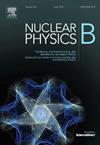Axion effects on new p-wave superconductors induced by electromagnetic fields
IF 2.8
3区 物理与天体物理
Q2 PHYSICS, PARTICLES & FIELDS
引用次数: 0
Abstract
Based on the holographic duality, we construct the new p-wave metal/superconductor phase transitions triggered by the electric and magnetic fields. Especially, using the axion field, we introduce simultaneously the spontaneous (SBT) and explicit (EBT) breaking of translation and then investigate how the SBT and EBT corrections influence on the critical temperature, vector condensate and the optical conductivity. Concretely, for the case with pure electric field, both the EBT correction with weak SBT correction and the SBT correction lower the critical temperature and soften the energy gap. Interestingly, for the strong enough SBT correction, the increasing EBT correction enhances firstly and then inhibits the phase transition. Meanwhile, the increasing EBT correction suppresses the SBT effect on . At the lowest Landau energy level, the stronger SBT correction suppresses the phase transition for the weak magnetic field, whose inhibiting effect is finally eliminated by the strong enough magnetic field. The monotonic dependence of on the EBT correction only exists for the weak SBT correction. For the Landau energy level in the excited state, the monotonic dependence of on the EBT correction vanishes for the intermediate SBT correction with large magnetic field.
电磁场诱导的新型p波超导体的轴子效应
基于全息二象性,我们构建了由电场和磁场触发的新型p波金属/超导体相变。特别地,利用轴子场,我们同时引入了自发(SBT)和显式(EBT)的平移断裂,并研究了SBT和EBT修正对临界温度、矢量凝聚和光电导率的影响。具体而言,对于纯电场情况,弱SBT校正的EBT校正和SBT校正都降低了临界温度Tc,软化了能隙。有趣的是,对于足够强的SBT校正,增大的EBT校正先增强后抑制相变。同时,EBT校正的增加抑制了SBT对Tc的影响。在最低朗道能级处,较强的SBT校正对弱磁场的相变有抑制作用,这种抑制作用最终被足够强的磁场消除。只有在微弱的SBT改正中,Tc对EBT改正的单调依赖性才存在。对于激发态朗道能级,在大磁场下的中间SBT校正中,Tc对EBT校正的单调依赖性消失。
本文章由计算机程序翻译,如有差异,请以英文原文为准。
求助全文
约1分钟内获得全文
求助全文
来源期刊

Nuclear Physics B
物理-物理:粒子与场物理
CiteScore
5.50
自引率
7.10%
发文量
302
审稿时长
1 months
期刊介绍:
Nuclear Physics B focuses on the domain of high energy physics, quantum field theory, statistical systems, and mathematical physics, and includes four main sections: high energy physics - phenomenology, high energy physics - theory, high energy physics - experiment, and quantum field theory, statistical systems, and mathematical physics. The emphasis is on original research papers (Frontiers Articles or Full Length Articles), but Review Articles are also welcome.
 求助内容:
求助内容: 应助结果提醒方式:
应助结果提醒方式:


